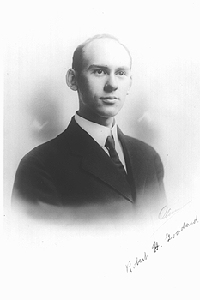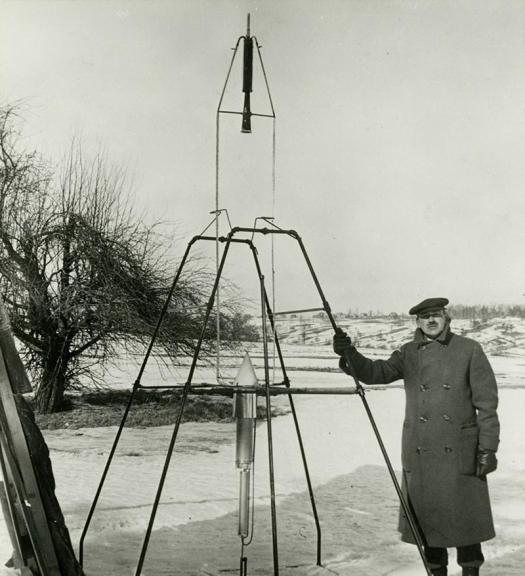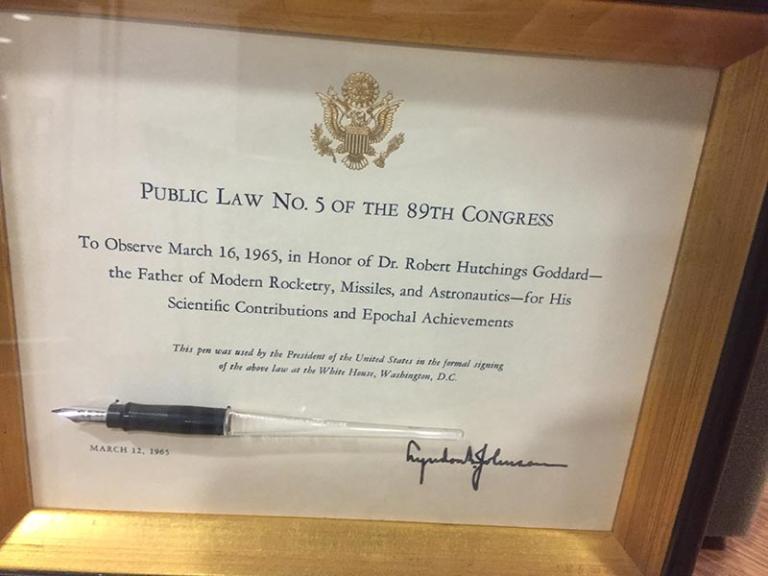Robert Goddard
Class of 1908 and Father of Modern Rocketry

Robert Goddard, often called the "Father of Modern Rocketry," graduated from WPI in 1908, a general science major. Even as an undergraduate student, Goddard dreamed of space flight, submitting an article, "Possibility of Investigating Interplanetary Space," to Scientific American in 1907. Also while an undergraduate, Goddard published an article in the WPI Journal, which at the time was devoted to technical literature. The article dealt with the use of the gyroscope in balancing and steering airplanes.
Despite his scientific interests, Goddard seems to have been popular among classmates, being elected class vice president and president and serving as editor of the class yearbook.
After graduation, Goddard served on WPI's Physics Department faculty for two years, and then did advanced study at Clark University. During this time, he continued to use WPI facilities for his experiments. Legend has it that while using a lab in Salisbury, explosions caused some damage and he was then moved to the Magnetic Lab (now Skull Tomb). Even here, neighbors complained of hearing loud noises.
Goddard went on to lay the foundations for the development of long range rockets, missiles, satellites and spaceflight. He was the first to use liquid propellants as rocket fuel, with the first successful launch of a liquid-fueled rocket from Auburn, Massachusetts, March 16, 1926. After his teaching career at Clark ended in 1934, Goddard worked for the U.S. government on rocket research until his death in 1945.

In 1926, Robert Goddard launched the first liquid-fueled rocket.

The pen President Johnson used to sign the law on March 16, 1965 recognizing Robert Goddard's contribution to modern rocketry.
Chronological History of the Career of Robert H.Goddard
| DATE | EVENT |
|---|---|
| 1882 | Born at Maple Hill, Worcester, Massachusetts |
| 1883 | Moved with family to Boston, Massachusetts |
| 1898 | Moved with family to Maple Hill, Worcester, Massachusetts |
| 1904-1908 | Student, Worcester Polytechnic Institute (B.S. in 1908) |
| 1908-1909 | Faculty, Dept. of Physics, WPI, and special student in Physics, Clark University |
| 1909-1911 | Fellow in Physics, Clark University (A.M. 1910, Ph.D. 1911) |
| 1911-1912, 1914-1915, 1918-1920 | Honorary Fellow in Physics, Clark University |
| 1912-1913 | Research instructor in Physics, Princeton University |
| 1914, July | Awarded first two patents for a rocket apparatus: A Liquid Fuel Gun Rocket, and a Multistage Step Rocket. |
| 1917, January 5 | Received first financial assistance from the Smithsonian Institution |
| 1920-1923 | Part-time consultant on solid propellant rocket weapons for U.S. government at Indian Head, Maryland |
| 1923-1943 | Director of Physical Laboratories, Clark University |
| 1924, June 21 | Married Esther Christine Kisk |
| 1926, March 16 | First to develop and launch a liquid-propellant rocket, at Auburn, Massachusetts. |
| 1930, July 10 -1932 | First two-year grant from Daniel Guggenheim, began conducting full-time rocket research at Roswell, New Mexico (on leave of absence from Clark University) |
| 1942-1945 | Director of Research, Navy Dept., Bureau of Aeronautics developing jet-assisted takeoff and variable thrust liquid propellant rockets, at Roswell, New Mexico and Annapolis Maryland |
| 1943-1945 | Consulting Engineer, Curtiss-Wright Corporation, Caldwell, New Jersey |
| 1944-1945 | Director, American Rocket Society |
| 1945, June 2 | Received honorary Doctor of Science degree, Clark University |
| 1945, August 10 | Died at Baltimore, Maryland. Buried at Hope Cemetery, Worcester, Massachusetts |
Chronological History of the Scientific Accomplishments of Robert H.Goddard
| DATE | EVENT |
|---|---|
| 1912 | First explored mathematically the practicality of using rocket power to reach high altitudes and escape velocity |
| 1915 | First proved experimentally that a rocket will provide thrust in a vacuum |
| 1917-1918 | Developed the basis for the rocket weapon, The Bazooka, done for U.S. Army Signal Corps and Ordinance Department, in the Magnetic Lab (now Skull Tomb) at Worcester Polytechnic Institute, at Clark University, and later at the Mount Wilson Observatory in California |
| 1919 | Published "A Method of Reaching Extreme Altitudes," in Smithsonian Miscellaneous Collections, Vol.71, No. 2, a basic mathematical theory underlying rocket propulsion |
| 1920-1925 | First to develop a rocket motor using liquid propellants |
| 1925 | Liquid-propellant rocket lifted its own weight for first time |
| 1926, March 16 | First to develop and launch a liquid-propellant rocket, at Auburn, Massachusetts |
| 1929, July 17 | Tested first rocket containing instruments in Auburn, Massachusetts |
| 1932 | First developed gyro stabilization apparatus for rockets |
| 1932 | Used deflector vanes in the blast of the rocket motor as a method of stabilizing and guiding rockets |
| 1934-1942 | "A" series rocket tests (14-test series; rockets at this stage were about 15 feet long) |
| 1935, March 8 | First to launch a liquid propellant rocket which attained a speed greater than that of sound (700 m.p.h.) |
| 1935 | Rocket reached altitude of 7500 feet |
| 1936, March 16 | Publication of "Liquid Propellant Rocket Development," Smithsonian Miscellaneous Collections, Vol. 95, No. 3 |
| 1936-1938 | "L" series rocket tests (30-test series; rockets were about 18 feet long) |
| 1937 | Rocket reached height of 9000 feet |
| 1938-1941 | "P" series rocket tests (This 36-test series represents his last flight rockets. Rockets averaged about 22 feet in length) |